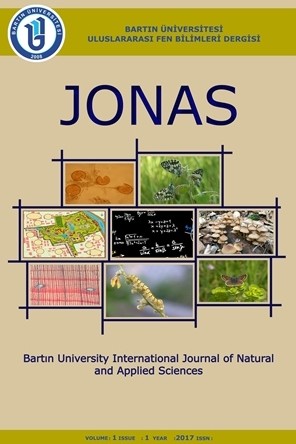KENTSEL DÖNÜŞÜM PROJELERİNE EKOLOJİK BOYUT KAZANDIRILMASINA İLİŞKİN GÖRÜŞLER
Kentsel dönüşüm, ekolojik kentsel tasarım, ekolojik kentsel planlama, ekolojik mimari
OPINIONS ON THE ECOLOGICAL DIMENSIONS OF URBAN TRANSFORMATION PROJECTS
Urban transformation, ecological urban design, ecological urban planning, ecological architecture,
___
- 1. Adil S. (2010). Ekolojik Kentleşme Ve Toplu Konutlarda Ekolojik Planlama Yaklaşımı, Bahçeşehir Üniv. Fen Bilimleri Enstitüsü, Y. Lisans Tezi, İstanbul.
- 2. Ahmadpour Hosseınızad S. F. (2015). Ekolojik Tasarım İlkeleri Bağlamında Tebriz Geleneksel Konutlarının İncelenmesi, KTÜ, Fen Bilimleri Enstitüsü, Y. Lisans Tezi, Trabzon.
- 3. Ataöv A., Osmay S. (2007). Türkiye'de Kentsel Dönüşüme Yöntemsel Bir Yaklaşım, Metu Journal of the Faculty of Architecture, 24 (2), 57-82.
- 4. Atabay İ. vd. (2012). Kentsel Dönüşüm Politikaları, İller ve Belediyeler Dergisi, Sayı 768, 20-27.
- 5. Selçuk B., Aydoğdu İ. (2014). Kentsel dönüşüm üzerine düşünceler: kazanım mı kayıp mı?, Cumhuriyet Üniversitesi İktisadi ve İdari Bilimler Dergisi, 15 (2), 33-53.
- 6. Meder M., Bal S., (2017). Türkiye’de Soylulaştırma: Ankara Dikmen Vadisi Örneği, Pamukkale Üniv. Sosyal Bilimler Enst. Dergisi, 32, 211-223.
- 7. Badr T. R.(2012). Toplu Konut Yerleşimlerinin Ekolojik Kentsel Tasarım İlke Ve Ölçütlerine Uygunluk Yönüyle Sınanması İçin Bir Çerçeve Oluşturulması: Ankara’da Saha Çalışması, Gazi Üniv. Fen Bilimleri Enstitüsü, Y. Lisans Tezi, Ankara.
- 8. Erdede S. B., Erdede, B., Bektaş, S. (2014). Kentsel Dönüşümde Yeşil Binaların Uygulanabilirliği, Ondokuz Mayıs Üniv., Harita Müh. Bölümü, 5. Uzaktan Algılama-CBS Sempozyumu (UZAL-CBS 2014), 14-17 Ekim 2014, İstanbul.
- 9. Çelikyay S. (2016). A Theoretical Framework on Retro-Fitting Process Based on Urban Ecology (Chapter:11), in Sustainable Urbanization, Ed: Mustafa Ergen, InTech Open, 251-267.
- 10. Çepel N. (1992). Doğa, Çevre, Ekoloji ve İnsanlığın Ekolojik Sorunları, Altın Kitaplar, İstanbul.
- 11. Demirtaş Y., Esgin İ. (2006). Bir Kentsel Yenileme Deneyimi: Barselona, Planlama Dergisi, 36, 155-162.
- 12. Ergan N.G, Şahin B. (2007). Kentsel Dönüşüm Projesi Kapsamındaki Hacılar Mahallesinde Yaşayanların Bu Projeye Bakışları, Edebiyat Fakültesi Dergisi, 24 (1), 83-106.
- 13. Güvenç B. (2008). Sürdürülebilirlik Bağlamında Ekolojik Tasarım Prensiplerinin Mimaride Uygulanabilirliğinin İrdelenmesi, YTÜ, Fen Bilimleri Enstitüsü, Y.Lisans Tezi, İstanbul.
- 14. Karakurt Tosun E. (2017). Sürdürülebilirlik Bağlamında Ekolojik Kent Söylemi, AİBÜ Sosyal Bilimler Enstitüsü Dergisi, 17 (4), 169-189.
- 15. Keleş R. (1998). Kentbilim Terimleri Sözlüğü, İmge Kitabevi Yayınları, Ankara.
- 16. Ünal S. G. (2014). Ankara Sinpaş Altınoran Konut Projesi ve Ekolojik Tasarım, Planlama Dergisi, 24(2), 95-106.
- 17. Tönük S. (2001). Bina Tasarımında Ekoloji, YTÜ, Mimarlık Fak., Yayın no: 01-005, İstanbul.
- 18. Yalçıner Ercoşkun Ö. (2007). Sürdürülebilir Kent İçin Ekolojik-Teknolojik (Eko-tek) Tasarım: Ankara-Güdül Örneği, Gazi Üniv., Fen Bilimleri Enstitüsü, Doktora Tezi, Ankara.
- 19. URL-1 https://www.dunyabulteni.net/tarih-dosyasi/mostar-koprusu-27-yil-once-bombalanmisti-h345513.html , Erişim Tarihi: 28.07.2019
- 20. URL-2 https://tr.depositphotos.com/147562687/stock-photo-panorama-of-the-old-bridge.html, Erişim Tarihi: 28.07.2019
- 21. URL-3 http://buildingoursustainablefuture.blogspot.com201209european-village-in-bo01.html, Erişim Tarihi: 28.07.2019
- 22. URL-4 http://www.csbr.umn.edu/work/bo01.html, Erişim Tarihi: 28.07.2019
- 23. URL-5 https://www.urbangreenbluegrids.com/projects/bo01-city-of-tomorrow-malmo-sweden/, Erişim Tarihi: 28.07.2019
- 24. URL-6 http://www.kadikoyakademi.org/barselona-super-bloklar-sayesinde-arabalari-kent-merkezinden-uzaklastiriyor/, Erişim Tarihi: 28.07.2019
- Yayın Aralığı: Yılda 2 Sayı
- Başlangıç: 2017
- Yayıncı: Bartın Üniversitesi
HAVAN MÜHİMMATI TAPALARINDA EMNİYET MEKANİZMALARININ İNCELENMESİ
Serhad YILDIZ, Zühtü Onur PEHLİVANLI
YEŞİLYURT (MALATYA) TARİHİ KENT DOKUSUNUN İRDELENMESİ
Ekrem KARAARSLAN, Selma ÇELİKYAY
THE EFFECT OF COAL MINING ON THE WATER QUALITY OF WATER SOURCES IN NIGERIA
Oloche Robert EKWULE, Gabriel Delian AKPEN, George Moses UGBEDE
Emprou EMINOUGLOU, Mustafa ÖZKAN, Belgin ELİPEK
SAMSUN-ÇARŞAMBA’DA PLANLAMA SÜRECİNİN KENTSEL PEYZAJ AÇISINDAN İRDELENMESİ
LAVANTA TARIMI VE SÜRDÜRÜLEBİLİR KALKINMA: ISPARTA/KEÇİBORLU-KUYUCAK KÖYÜ ÖRNEĞİ
Yeliz TARHAN, Sebahat AÇIKSÖZ, Deniz ÇELİK
Süheyla ÜNAL, Mustafa KARAKAPLAN, Erdinç ÖZ, İsmet YILMAZ, Serdar ALTIN, Ali BAYRİ
EFFECT OF BIOMASS HYDROLYSATE ON SOIL AND PLANT PHENOLIC CONTENTS
